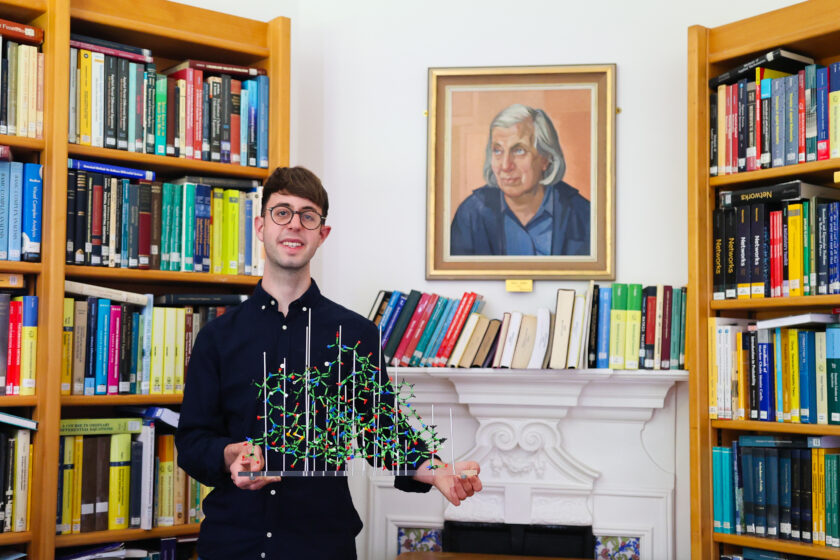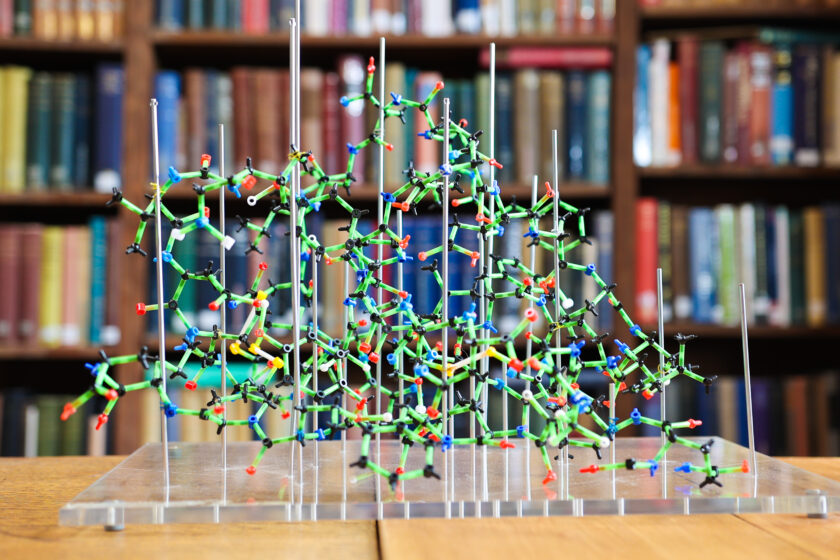Mason Wakley (2020, Chemistry) has been getting in touch with Somerville’s history by rebuilding Dorothy Hodgkin’s model of insulin.
Mason noticed that the model, stored in Somerville’s library, was in a state of disrepair. When he found out that this year was the 60th anniversary of Hodgkin’s Nobel Prize, it felt like the moment to bring this model back to life.
Mason’s initial challenge was trying to use the original parts of the model; since they were around 60 years old, the plastic kept snapping. However, thanks to Somerville chemists Georgia Fields (2020), Matt Lurie (2023) and Marshall Hunt (2020), Mason gathered enough donations of old molecular model kits to rebuild the model.

Mason and the model, with Dorothy Hodgkin’s portrait
After putting together the amino acids in the correct order, the next challenge was taking something essentially 2D and turning it into the 3D model. Somerville library’s collection of Hodgkin’s research papers proved useful, but the fiddly nature of the construction could only be tackled by trial and error – and lots of patience!
Hodgkin began investigating insulin in 1934, the year she was appointed Somerville’s first Tutor in Chemistry. She was fascinated by its wide-ranging effect on the body, but at that point, X-ray crystallography could not handle the insulin molecule’s complexity. In 1969, Hodgkin and her team were finally able to uncover the structure of insulin. This was instrumental in enabling insulin to be mass-produced to treat diabetes.
The process reminded me of the complexity and specificity of biology, as well as Hodgkin’s outstanding ability to take often confusing crystallographic data and translate it into something meaningful.
Mason Wakley

Dorothy Hodgkin’s model of insulin
Dorothy Hodgkin played a significant role in Somerville’s history; her winning the Nobel Prize in 1964 was a momentous occasion. Hodgkin remains the only British woman scientist to have been awarded a Nobel Prize in science. She was deeply committed to Somerville, and used a large part of her Nobel Prize money to establish Somerville’s nursery. Whilst the Nobel was awarded for her work establishing the structures of vitamin B12 and penicillin, her work on insulin was equally extraordinary.
Mason has been involved with scientific journalism throughout his time at Somerville, and enjoys sharing his love of science, particularly with people from a non-STEM background. He hopes this model can play a part in that, and plans to display it in the library’s Dorothy Hodgkin room. As he prepares to leave College, Mason reflected, ‘I’m proud to be a part of the legacy of chemists here at Somerville, and this project felt an appropriate way to express that. As my time at Somerville comes to an end, it’s also nice to leave my own mark on the course of college history.’